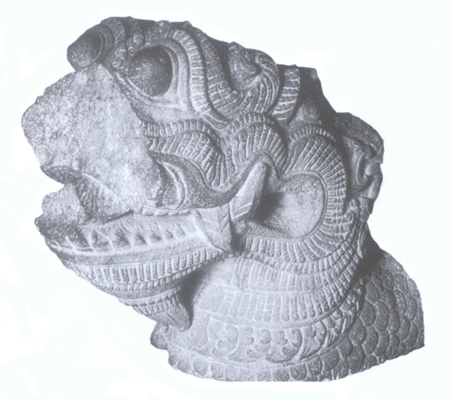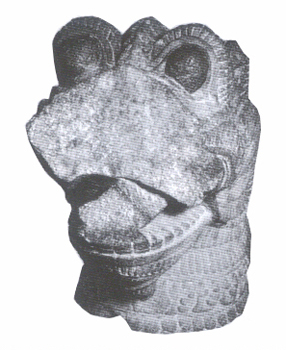Style THKP Mam. XII - XIII siècle.Grès, long. 91 cm width. 40 cm high. 84 cm. (Natural History Museum in Lyon, No. 81001998).

This fragment of a dragon has all the characteristics of style Thdp Mani, with its excesses and its strong originality. Its uniqueness is still plenty of scenery, which occupies the entire space carved minutely. It includes the series "splices" the neck and around the ears, the reason Thdp Mom "necklace from the actual body and neck. This pattern is the "signature style of the same name (which ranges from the late eleventh century to the early fourteenth century), since the work of Dr. Stern1.
The salon, which extends the bulging eyes, is quite extravagant: from both sides of a ridge redentée aligns a series of five horizontal strands, each at a different twist. We find this pattern on the head of the lions of the Atlantean period. We know that the dragon is part of the Cham bestiary from the tenth century, perhaps under the influence Sino-Vietnamese, and it appears in the Khmer sculpture with the style of Angkor Wat.

There, at the Museum of Da Nang, three types of dragon within the period of two quite distinct traditions in our opinion. The first type, with large bells, which are two known examples, the monster is lying in a submissive position (No. 42.48 and 42.49 of this museum), the second, the hind legs together in a kind of upright column is equipped large curved horns and has no lower teeth. These two dragons are probably much to the influence of Vietnam, although this influence remains to be analyzed in detail. The third type, represented in Da Nang by two mutilated statues placed at the entrance to the driveway of the Museum (No. 42.2 and 42.3), shows a dragon standing up revealing some continuity with the dragon-Tra Kieu. This is the type that belongs to Lyon, the latter having even more stylized fangs
"The works of the Cham Museum of Natural History in Lyon Emmanuel Guillon
Dr. Stern 1, 1942, on the pedestal K breasts, pl. 45.
Article de "La Lettre de la SACHA" n°1, july 1997, pages 6 et 7.


 James H.W. Thompson Foundation, Bangkok, Thailand.
James H.W. Thompson Foundation, Bangkok, Thailand.